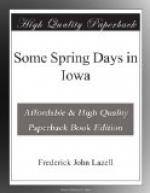For long we sit and drink in the beauty of the scene. Meanwhile the birds on this wooded slope are asking us to use our ears as well as our eyes. Such a mingling of bird voices! The “spring o’ th’ year” of the meadow larks and the mingled squeaks and music of the robins are brought up by the wind from the river bottom, and the shrill clear “phe-be” of the chickadee is one of the prettiest sounds now, just as it was in February. Pretty soon a bevy of them come flitting and talking along, like a girl botany class on the search. Before they have passed out of sight the loud and prolonged “O-wick-o-wick-o-wick-o-wick” of the flicker makes us lift our eyes to the top of a scarlet oak and anon three or four of the handsome fellows alight nearer by so that we may the better admire their white-tailed coats, brown shoulders, scarlet napes and the beautiful black crescent on their breasts. When we hear the call of the flicker we may know that spring is here to stay. They are as infallible as the yellow-breasted larks in the meadows.
“Chip-chip-chip-chip,”—yes, of course that’s the chipping sparrow; another of the engaging creatures which almost has been driven from the habitations of his human friends by the miserable English sparrows. Often have we seen the little fellow set upon and brutally hurt by these pirates. Now he stays around rural homes, and his chestnut crown, brown coat mixed with black and gray, his whitish vest and black bill are always a welcome sight. He takes up the chant of the year where the departing junco left it off, throws back his tiny head and his little throat flutters with the oft-repeated syllable, continued rapidly for about four seconds. A while longer we wait and are rewarded by a few bars of the musicful song of the brown thrasher who has just arrived with Mrs. Thrasher for two weeks of courtship and song, after which they will build a new home in the hazel thicket and go to housekeeping.
Just as we are rising to leave there is the glimmer of the blue-bird’s wing and the brilliant fellow and his pretty mate appear at the top of the bank, where the staghorn sumac still bears its berries. None of the birds of the winter seems to care much for these berries but the bluebirds evidently love them. As another instance of their tastes in this direction may be mentioned the fact that for the past three weeks a pair of blue birds have made many visits every day to a Chinese matrimony vine, by the dining room window of the writer’s home. This vine, as everyone knows, has a wreath of juicy red berries in the fall, which hang through the winter and are dried, but still red, in the spring. It was the first week of March when the family first heard the pleasing notes of the blue bird outside the window at breakfast time, and saw the brilliant male sitting on a post on the back lawn and his less brilliant, but equally attractive mate sitting on the clothesline. A little later and he flew to the




